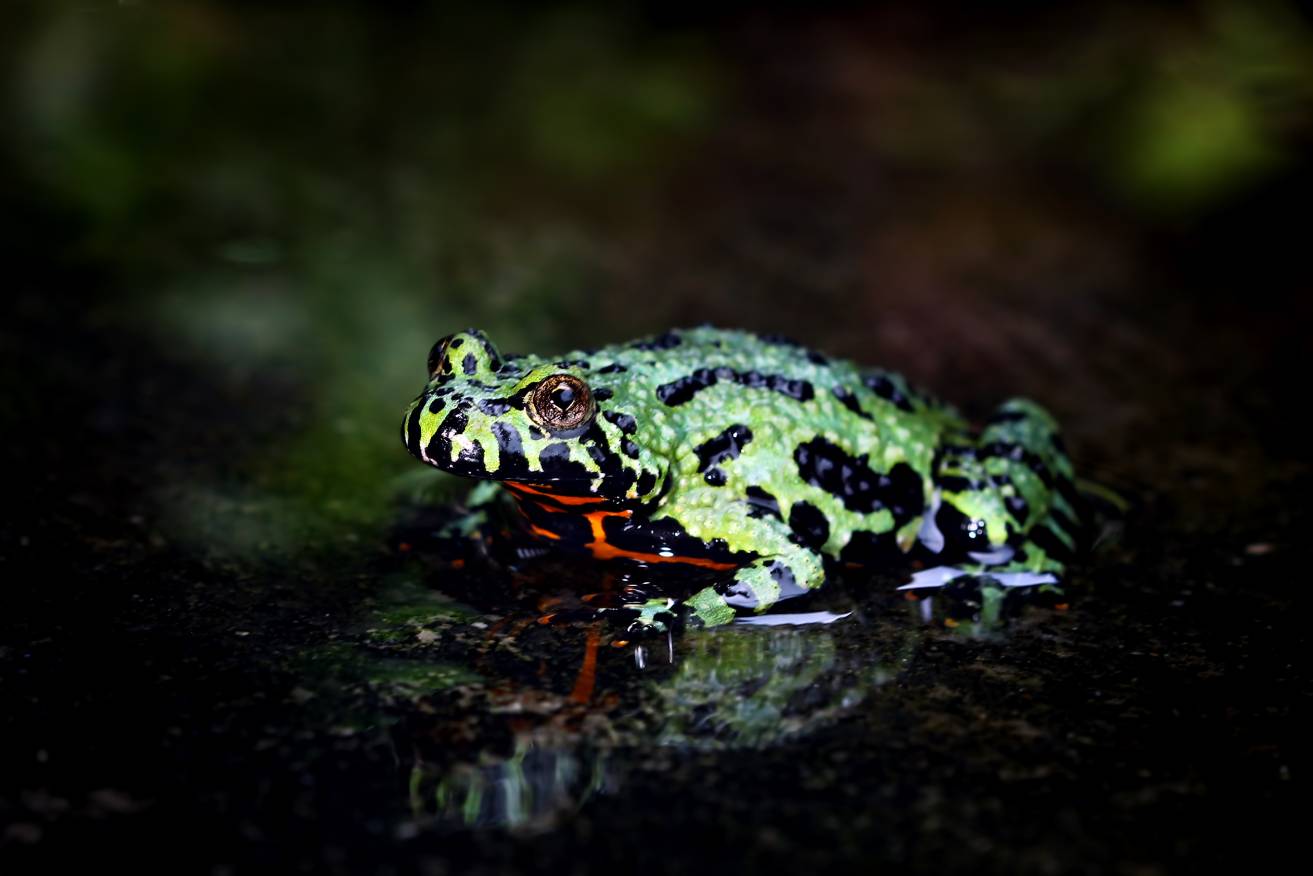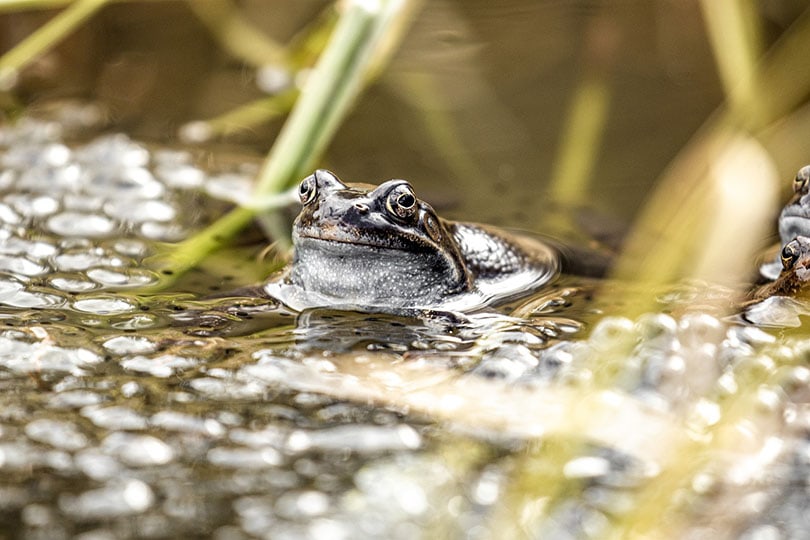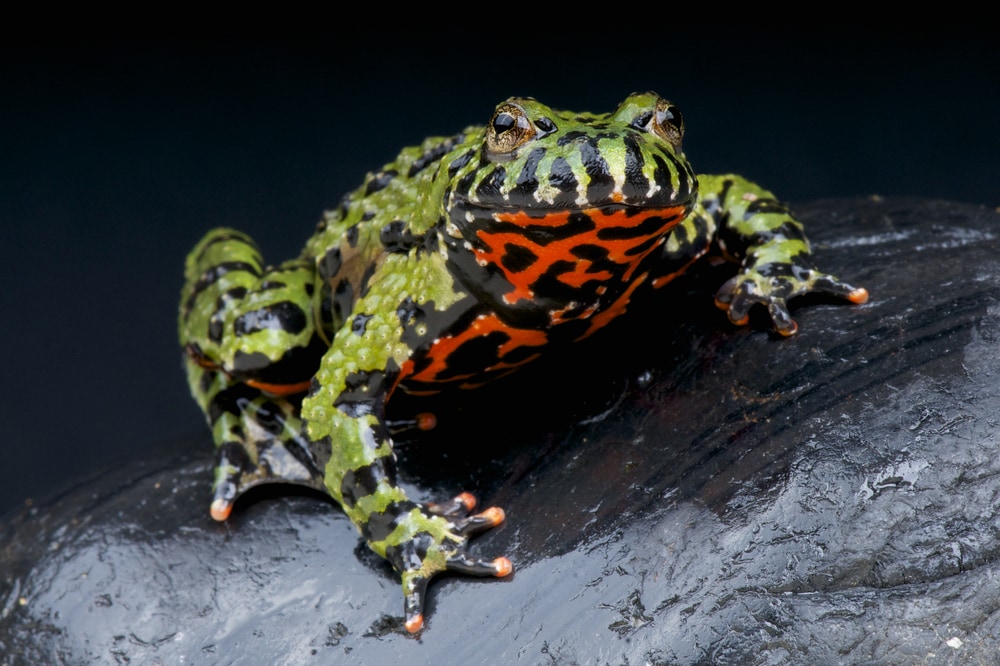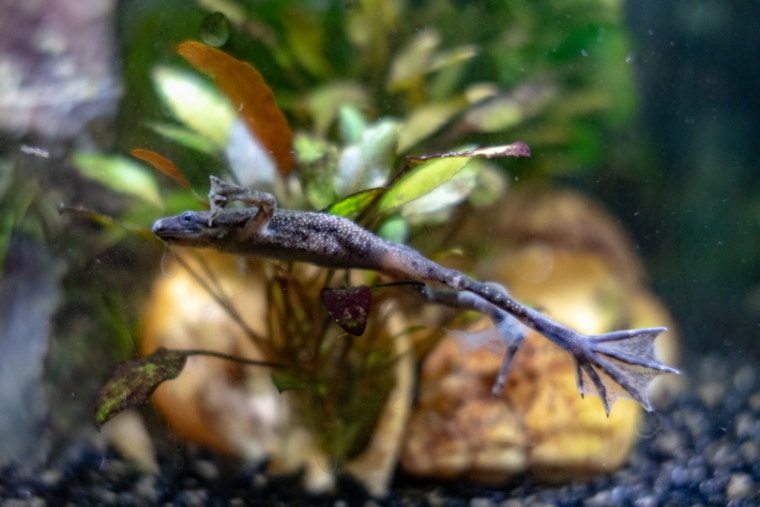
The African dwarf frog is a totally aquatic amphibian that can live peacefully among a large selection of fish. They can add pizzazz to any aquarium as they are avid, active swimmers.
If you’re looking for additions to your setup, these frogs might be a smart choice for you. They are social and interactive in the tank, getting along with almost all tankmates. So, let’s dig deeper into the traits of this amphibian to discover if the African dwarf frog is the next pet for you.
Quick Facts about African Dwarf Frog

| Species Name: | Hymenochirus |
| Family: | Pipidae |
| Care Level: | Intermediate |
| Temperature: | 68-78 degrees Fahrenheit |
| Temperament: | Social, docile |
| Color Form: | Olive to brown |
| Lifespan: | 10-15 years |
| Size: | 3 inches |
| Diet: | Omnivore |
| Minimum Tank Size: | 10-gallon |
| Tank Setup: | Freshwater |
| Compatibility: | High |
African Dwarf Frog Overview
African dwarf frogs are completely aquatic amphibians that require no time on land. In their native habitat, they dwell in rivers and streams of Africa. This interesting critter has lungs and surfaces the water to breathe.
These tropical frogs love warm water and pair well with many other freshwater pals that enjoy it, too. These frogs are inexpensive, easy to find, and relatively low maintenance.
Because they are so plentiful, you can replenish your supply as needed, or add new frogs to another aquarium. They’re also relatively easy to breed in captivity.
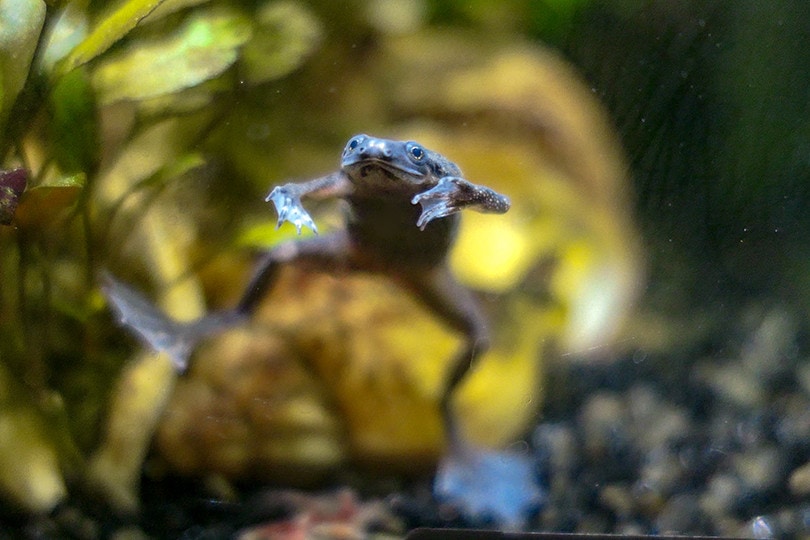
How Much Do African Dwarf Frog Cost?
You can find African dwarf frogs in just about any pet shop across the country. They are extremely popular because of their adaptability and peacefulness.
Another upside is that they are relatively cheap, especially in comparison to some other frog species. If you are shopping around, you’ll generally find prices are between $3 and $10.
Since these frogs build relationships with each other, the low price allows you to buy more than one at a time. Even though you can buy a singular frog, it’s best to opt for a pair or more to enhance their quality of life.
 Typical Behavior & Temperament
Typical Behavior & Temperament
African dwarf frogs are entertaining creatures to watch. They actively swim around their enclosures among other frogs and fish without issues. But they might occasionally mistake much smaller aquatic life for food.
When they aren’t zipping around their tank, they may take on a behavior called “burbling.” They remain still in the water with all four limbs outstretched and remain completely still. These actions are entirely normal and expected.
African dwarf frogs can hang out in practically any area of the tank. They use the bottom for relaxation and the top for oxygen.
Appearance & Varieties
These tiny frogs can vary a bit in color, but they range from olive to brown. So, there aren’t a lot of vibrant colors to choose from. Both genders also share distinct black spots on their bodies that are true to the species.
You can tell them apart since males have post-axillary subdermal glands on the back of their front legs—appearing as white dots. Both males and females only reach about 3 inches as adults.
How to Take Care of African Dwarf Frog
For any aquatic creature, making sure the living conditions are ideal can be a bit tricky. However, these amphibians are quite simple to care for, especially if you already have experience with tropical freshwater life.
Habitat, Tank Conditions & Setup
For a perfect setup, here are some things to consider when you’re preparing.
Tank
If you have an existing aquarium with aquatic life, you will need at least a 20-gallon enclosure if they live with other frogs or fish.
However, if you only have one or two African dwarf frogs, one 10-gallon aquarium would suffice. As always, the larger, the better.
Substrate
Both sand and gravel substrates are excellent for African dwarf frogs. However, you can also have a bare bottom. Sometimes, if gravel is large enough, it can pose health risks if a frog were to eat it by accident, so get correct pebble sizes when you purchase.
If you choose to have no substrate, keep in mind that you will have to clean more often.

Temperature
Since African dwarf frogs are tropical creatures, they love warm water. You should keep your tank between 68 to 78 degrees Fahrenheit.
You can use an aquarium heater to control the ideal temperature. Keep the tank away from drafty areas, such as near doors or windows.
Water
Clean, debris-free water is absolutely vital for your African dwarf frog’s wellbeing. Water quality has to be exact—you can’t toss them into a tub of tap water. You need an appropriate water filter to make sure that the water cycles out any buildup.
They need appropriate aeration lines and filtration systems in place with the ideal pH. Water pH should stay between 6.5 and 7.5. Ensure to test the water beforehand and use a pH adjuster if it isn’t in this range.
Lighting
African dwarf frogs are easy-peasy when it comes to lighting. They don’t require any particular heating or basking lights—no bells or whistles needed. They simply need the natural daytime/nighttime light cycles to stay happy.
Do African Dwarf Frogs Get Along with Other Pets?
African dwarf frogs are very adaptable and agreeable with other tankmates. They get along fantastic with their kind—and they don’t mind having fish around, either. They can coexist with just about any critter they can’t fit in their mouth.
However, you should avoid having fish in a tank that is much smaller than your frogs. They will view these fish as food if they get hungry enough.
What to Feed Your African Dwarf Frog
African dwarf frogs are omnivorous, meaning they eat plant and meat matter. In the wild, these frogs eat small fish and insect larvae.
In captivity, however, they need high protein diets that follow consistent feeding schedules. Your dwarf frog needs to eat one to two times a day. If your frog food is frozen, you will need to thaw it completely before offering.
Keeping Your African Dwarf Frog Healthy
Overcrowding is one of the primary causes of African dwarf frog stress and illness. Make sure all of your aquatic critters have adequate space to swim around without restriction. As long as these guys have clean water and healthy diets, they are generally very healthy little creatures. But they can be susceptible to certain illnesses and fungal or bacterial infections.
If you notice any odd symptoms, you must seek treatment right away. Your frog isn’t the only one who can get these illnesses, so it’s crucial to treat the entire tank.
Breeding
When it comes to breeding the African dwarf frog, it isn’t an extensive process. If you fluctuate water temperature and lower the overall level a bit, it can entice breeding.
Feed them a diet of brine shrimp and traditional fish flakes to keep up their metabolism and prepare them to be healthy breeders.
Once the conditions are right, males will start “practicing” by creating a grasping position with their arms. After a bit of this, they will latch on to any frog they see. If it is a receptive female, the breeding process, known as amplexus, will occur.
During the mating process, the female deposits eggs each time they surface the water together. The entire process is finished within 7 hours. They might deposit up to 1,000 eggs at a time, so be mindful of the mess of frogs this could create.
Floating eggs indicate reproduction is successful. Typically, the eggs will hatch in a short window of 2 days or less.
Are African Dwarf Frog Suitable for You?
So, does the African dwarf frog sound like a good fit for your aquarium? These guys are easy for beginners and novice aquarists alike—making agreeable, interactive tank mates that are tons of fun to watch in action.
These frogs make excellent additions to most tropical freshwater setups. However, they might eat smaller fish if they get too hungry. Always make sure to check compatibility with your existing fish.
See also:
- African Dwarf Frogs For Sale: Breeders List
- What Do African Dwarf Frogs Eat in the Wild and As Pets?
Featured Image Credit: Charlie Tyack, Shutterstock



